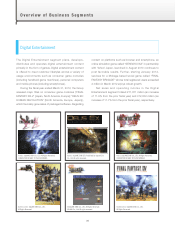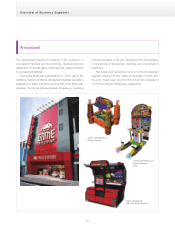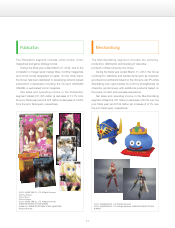Square Enix 2012 Annual Report Download - page 8
Download and view the complete annual report
Please find page 8 of the 2012 Square Enix annual report below. You can navigate through the pages in the report by either clicking on the pages listed below, or by using the keyword search tool below to find specific information within the annual report.
To Our Shareholders
the right device depending on the way in which that device
intersects with our lives. If such delineations are drawn
accurately, the user base for games will expand further. Lastly,
the revenue recognition model has fallen behind the most
among these three points. For online services connected to
game consoles, the console manufacturers are the publishers.
Unless these manufacturers change their policy and implement
necessary features, nothing will change. The business model
change has begun partially with PDLC, but even the subscription
model is rarely accepted, and manufacturers are still not open
to the F2P model. I feel that one of the fundamental causes of
the declining trend of the game console market is the delay in
implementing new business models. This is regretful. However,
if we take another perspective, all it takes is for manufacturers
to change their ways of thinking, and change could happen
overnight. I am eagerly awaiting this change in policy.
Our strategy in this area is: 1) Modifying our game design
on the premise of change in business models, 2) Focusing on,
and nurturing 10 strong IPs, since keeping a continuous
relationship with consumers is important, and 3) Not compromising
on quality. In order to achieve 1), we are actively applying our
knowledge from MMO and SN games. In addition to regular
sessions for sharing information across our organization, we require
individual projects to identify issues related to business models.
Regarding point 2), I have been long mentioning it as one of the
pillars of our strategy. I would like to expound on point 3). The
reality is that game development has become so costly and
complicated that the whole industry is at a loss. It is understandable
why game engines took the industry by storm in the 2000s.
We have two strategic options open to us for game
development. One option is to take full advantage of open
environments, which allow for indie developers to be able to
develop games. However, many resulting products will be
casual-style games and it is unclear if we could generate
significant profits. Thus, in this scenario, we would seek to
minimize fixed costs. In other words, we would downsize to a
minimum capacity as a company and devote ourselves to
licensing out IPs without having internal development staff.
Another option is to exert our efforts to the fullest extent to
differentiate ourselves from our competitors. We have chosen
the latter path. You may have noticed a similar philosophy
expressed earlier in the Amusement and MMO games sections
of this message. Given this philosophy, we need to tackle the
establishment and evolution of our development environment as
a global task. Game engines are of significant relevance. We
use both third-party and internally developed engines. We are in
the midst of developing the “Luminous Studio” engine, with an
eye toward next-generation capabilities. We presented the
demo for the first time at the E3 game show in 2012, and the
reaction was greater than we had anticipated. We were able to
confirm that we are heading in the right direction.
The category I call HD games will eventually cease to be
necessary as a classification from both perspectives of business
model and devices on which they will run. It is not that the
market will shrink. But on the contrary, it means that current
console games will transform and further develop. When the
above three organizational categories will no longer be
necessary and we can propose a new business segment, we
will see an end to the industry’s current transition period.
The Transformation to Come
I have repeatedly stated that similar to other media industries,
the game business will be enveloped into the upheaval of the
ecosystem of the entire content industry. I believe that we are
nearing that moment, and I would like to discuss my outlook on
the future while touching upon the content industry as a whole.
The content business is composed of three functions:
Production, Commercialization, and Marketing. Marketing
includes promotion, distribution, and monetization. Taking an
example of the music sector, composition and performance
is the Production, recording and pressing on CDs is the
Commercialization, and selling CDs at retail stores is the
Marketing. In the game sector, the assets that we develop are
programs, and we cannot sell these programs “as is.” Therefore,
after Production, the Commercialization process is required.
Game console machines, on which game software can run, are
manufactured and sold. Then the program is pressed onto
DVDs and packaged. This is the Commercialization process,
and the console manufacturers fulfill this function. Marketing is
selling the packaged discs at retail stores. In any content
industry the basic structure is the same.
Since content is intangible, in order to do business, the
Commercialization, in other words reproducing the content onto
media, is an inevitable process. Marketing methods were
determined by the type of media. The content industry has been
segmented in accordance with the method of Commercialization,
which adds the highest value.
06





















